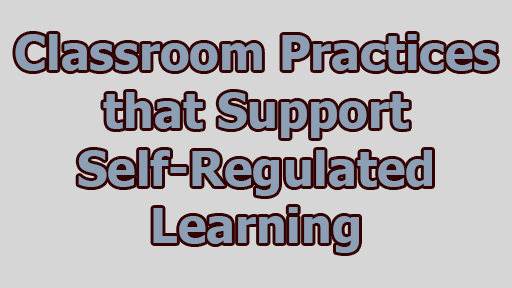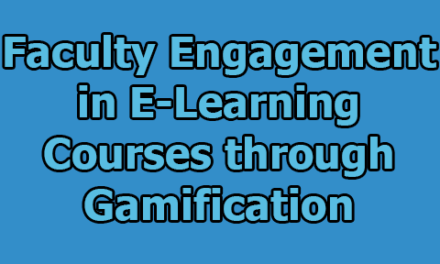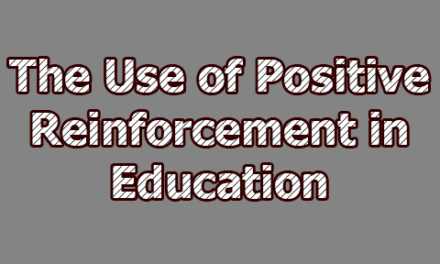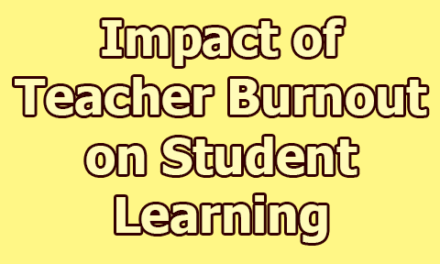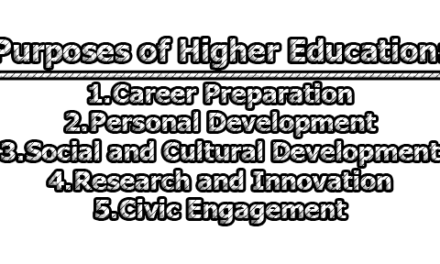Classroom Practices that Support Self-Regulated Learning:
Self-regulated learning (SRL) is a process through which learners take control of their learning, actively monitor their cognitive processes, and make adjustments to enhance their learning outcomes. This approach encourages students to be proactive, responsible, and reflective learners. Implementing classroom practices that support self-regulated learning can significantly impact students’ academic achievement, motivation, and lifelong learning skills. This article will delve into various classroom practices that support self-regulated learning, including choices that involve higher-level decision-making, opportunities for negotiation and modification, self-evaluation, teacher support, feedback, engagement in complex tasks, goal setting, strategy use, monitoring, and evaluation.
I. Choices that Involve Higher-Level Decision-Making: Giving students opportunities to make choices involving higher-level decision-making empowers them to take ownership of their learning. Teachers can offer a range of options for learning tasks, assessments, or projects that align with the learning objectives. By allowing students to choose topics or approaches that interest them, they are more likely to be engaged and invested in their work. This practice nurtures autonomy and critical thinking skills, contributing to self-regulated learning.
II. Opportunities to Negotiate or Modify Learning Tasks: Students have diverse learning needs, and providing them with opportunities to negotiate modifications to learning tasks based on their preferences and abilities promotes self-regulation. Teachers should create a supportive environment where students feel comfortable expressing their needs and proposing adjustments to assignments or activities. This collaborative approach fosters a sense of agency and self-advocacy, leading to more meaningful learning experiences.
III. Student Self-Evaluation: Encouraging students to self-assess their work is a powerful tool for promoting self-regulation. Students should be taught how to evaluate their performance against specific criteria and set personal improvement goals. This process cultivates metacognitive skills, helping students become aware of their strengths and weaknesses, leading to more strategic and effective learning behaviors.
IV. Teacher Support Instrumental to Self-Regulated Learning: Teachers play a vital role in supporting students’ self-regulated learning. They should provide guidance, scaffold learning tasks, and model effective strategies. Being approachable and fostering open communication allows students to seek help when needed, ultimately strengthening their self-regulation skills.
V. Providing Feedback: Timely and constructive feedback is crucial for self-regulated learning. Feedback should be specific, actionable, and focused on the learning process rather than just the end product. Encouraging students to use feedback to make improvements enhances their ability to self-monitor and self-adjust their learning strategies.
VI. Engaging Students in Complex Tasks: Complex tasks require higher-order thinking skills and problem-solving abilities. Engaging students in such tasks to challenge them to plan, monitor, and evaluate their progress, fostering self-regulation. Teachers can design multi-faceted assignments that prompt critical thinking, collaboration, and creativity, promoting active involvement in the learning process.
VII. Analyzing the Learning Task: Before diving into a learning task, students should be encouraged to analyze it thoroughly. This involves breaking down the task, understanding the requirements, and identifying potential challenges or areas where they might need support. This analytical approach sets the foundation for effective self-regulated learning.
VIII. Goal Setting to Complete the Task: Goal setting is a fundamental aspect of self-regulated learning. Students should learn how to set specific, measurable, achievable, relevant, and time-bound (SMART) goals for their learning tasks. By setting clear objectives, students can monitor their progress, stay motivated, and make necessary adjustments to achieve success.
IX. Using Strategies for Learning Tasks: Introducing students to a variety of learning strategies empowers them to select the most suitable approach for different tasks. Strategies may include note-taking, summarization, concept mapping, or mnemonic techniques. Teachers can explicitly teach these strategies and encourage their application in various learning contexts.
X. Monitoring the Effectiveness of Strategies Used: As students use different strategies, they should be guided to monitor their effectiveness. Some strategies may work better for certain subjects or tasks, and self-regulated learners need to be able to adapt their approach based on what yields the best results.
XI. Monitoring Motivation to Complete the Task: Motivation is a critical factor in self-regulated learning. Students need to be aware of their motivation levels and identify factors that influence their engagement in the learning process. By recognizing when motivation wanes, they can take proactive steps to rekindle their interest and focus.
XII. Evaluation of the Performance of Learning Tasks: Self-regulated learners reflect on their performance after completing a task. They analyze the outcomes, identify strengths, and areas for improvement, and learn from their experiences. Teachers can facilitate this process by guiding students through reflective exercises and discussions.
XIII. Taking Responsibility for Learning Outcomes: A key principle of self-regulated learning is assuming responsibility for one’s learning outcomes. Students must understand that their effort, persistence, and learning strategies directly impact their achievements. Encouraging a growth mindset, where challenges are seen as opportunities for growth, can foster a sense of accountability.
XIV. Open and Flexible Tasks, Activities, and Assessments: Tasks, activities, and assessments should be designed to accommodate diverse learning styles and preferences. Open-ended and flexible approaches allow students to engage with the material in ways that align with their strengths and interests, enhancing self-regulated learning.
XV. Universally Designed Tasks for Meaningful Participation: Inclusive education emphasizes that all students, regardless of their abilities or disabilities, should have access to meaningful learning experiences. Universally designed tasks ensure that learning opportunities are accessible to all students, promoting equitable participation and self-regulation.
It is apparent that classroom practices that support self-regulated learning empower students to become independent, motivated, and reflective learners. By implementing choices, negotiation, self-evaluation, teacher support, feedback, complex tasks, goal setting, strategy use, monitoring, and evaluation, educators create an environment that fosters active engagement and personal responsibility in the learning process. Emphasizing the importance of metacognitive skills and promoting a growth mindset further enriches students’ self-regulatory abilities. By employing these comprehensive practices, educators can equip students with the tools necessary for successful learning not only in the classroom but throughout their lives.
References:
- Brenner, C. A. (2022). Self-regulated learning, self-determination theory and teacher candidates’ development of competency-based teaching practices. Smart Learning Environments, 9(1), 3. https://doi.org/10.1186/s40561-021-00184-5
- Öztürk, M., & Çakıroğlu, Ü. (2021). Flipped learning design in EFL classrooms: Implementing self-regulated learning strategies to develop language skills. Smart Learning Environments, 8(1), 2. https://doi.org/10.1186/s40561-021-00146-x

Former Student at Rajshahi University

